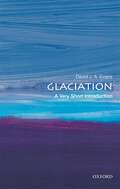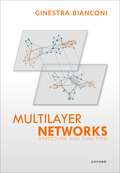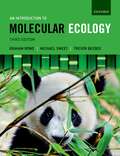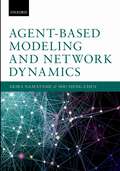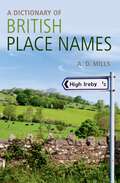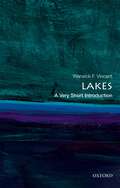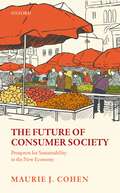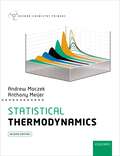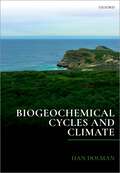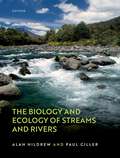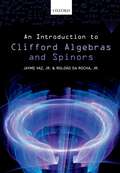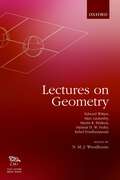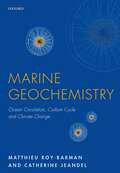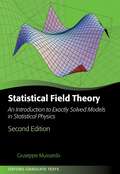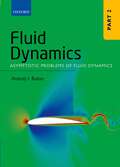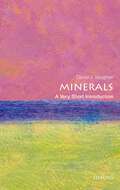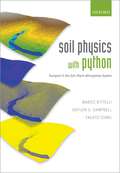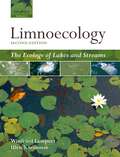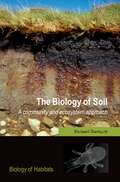- Table View
- List View
Glaciation: A Very Short Introduction (Very Short Introductions)
by David J EvansVast, majestic, and often stunningly beautiful, glaciers lock up some 10% of the world's freshwater. These great bodies of ice play an important part in the Earth system, carving landscapes and influencing climate on regional and hemispheric scales, as well as having a significant impact on global sea level. Throughout time, the Earth has experienced various major glaciations in its deep history, long before the ice ages of the Quaternary, and the observed effects of climate change on glaciers have recently brought them to the forefront of public attention This Very Short Introduction offers an overview of glaciers and ice sheets as systems, considering the role of geomorphology and sedimentology in studying them, and their impacts on our planet in terms of erosional and depositional processes. Looking at our glaciers today, and their ongoing processes, David Evans considers the extent to which we can use this knowledge in reconstructing and interpreting ancient glacial landscapes. ABOUT THE SERIES: The Very Short Introductions series from Oxford University Press contains hundreds of titles in almost every subject area. These pocket-sized books are the perfect way to get ahead in a new subject quickly. Our expert authors combine facts, analysis, perspective, new ideas, and enthusiasm to make interesting and challenging topics highly readable.
Multilayer Networks: Structure and Function
by Ginestra BianconiMultilayer networks is a rising topic in Network Science which characterizes the structure and the function of complex systems formed by several interacting networks. Multilayer networks research has been propelled forward by the wide realm of applications in social, biological and infrastructure networks and the large availability of network data, as well as by the significance of recent results, which have produced important advances in this rapidly growing field. This book presents a comprehensive account of this emerging field. It provides a theoretical introduction to the main results of multilayer network science.
An Introduction to Molecular Ecology
by Graham Rowe Michael Sweet Trevor BeebeeAn Introduction to Molecular Ecology combines theoretical concepts with practice-driven examples to showcase the latest molecular and genomic techniques and their impact on the study of ecology. The opening chapters introduce the essential molecular and genetic concepts that underpin the subject and describe key molecular tools and methods available to the ecologist. Capturing the broad scope of the field, the book goes on to explore the use of molecular tools in the context of behavioural ecology, population genetics, phylogeography, conservation, and microbial ecology. The third edition includes coverage of exciting new technological and analytical developments, such as next generation sequencing, which have revolutionized the field over the last decade. Molecular ecology is now in a position to tackle some truly ecological questions for the first time since its inception. Blending conceptual detail with the most instructive examples, An Introduction to Molecular Ecology is an ideal resource for those new to the subject needing to develop a strong working understanding of the field. Online Resource Centre The Online Resource Centre to accompany An Introduction to Molecular Ecology features: For students: - Suggested review articles to take your learning further - Links to useful websites and software - A range of questions to consolidate your learning and understanding For registered adopters of the book: - Journal Club; suggested research papers and discussion questions linked to topics featured in the book - Figures from the textbook to view and download
Agent-Based Modeling and Network Dynamics
by Shu-Heng Chen Akira NamatameWhile the significance of networks in various human behavior and activities has a history as long as human's existence, network awareness is a recent scientific phenomenon. The neologism network science is just one or two decades old. Nevertheless, with this limited time, network thinking has substantially reshaped the recent development in economics, and almost all solutions to real-world problems involve the network element. This book integrates agent-based modeling and network science. It is divided into three parts, namely, foundations, primary dynamics on and of social networks, and applications. The authors begin with the network origin of agent-based models, known as cellular automata, and introduce a number of classic models, such as Schelling's segregation model and Axelrod's spatial game. The essence of the foundation part is the network-based agent-based models in which agents follow network-based decision rules. Under the influence of the substantial progress in network science in late 1990s, these models have been extended from using lattices into using small-world networks, scale-free networks, etc. The text also shows that the modern network science mainly driven by game-theorists and sociophysicists has inspired agent-based social scientists to develop alternative formation algorithms, known as agent-based social networks. It reviews a number of pioneering and representative models in this family. Upon the given foundation, the second part reviews three primary forms of network dynamics, such as diffusions, cascades, and influences. These primary dynamics are further extended and enriched by practical networks in goods-and-service markets, labor markets, and international trade. At the end, the book considers two challenging issues using agent-based models of networks: network risks and economic growth.
A Dictionary of British Place-Names (Oxford Quick Reference)
by A. D. MillsThis revised edition of the Dictionary of British Place-Names includes over 17,000 engaging and informative entries, tracing the development of the featured place-names from earliest times to the present day. Included place-names range from the familiar to the obscure, among them 'Beer', 'Findlater', 'Broadbottom', and 'Great Snoring'. The A to Z entries are complemented by a detailed introductory essay discussing the chronology and development of English, Irish, Welsh, and Scottish place-names, as well as an extensive bibliography, maps of Britain showing old and new boundaries, and a glossary of common elements in place-names. Also new to this edition is an appendix of recommended web links pointing to relevant online resources, thereby expanding the scope of the dictionary and providing the reader with an opportunity to explore the subject further. Both accessible and up to date, this dictionary is an ideal companion for anybody travelling around the British Isles, as well as for researchers and students with an interest in toponomy, local history, cartography, and lexicography.
Lakes: A Very Short Introduction (Very Short Introductions)
by Warwick F. VincentFrom the mysterious depths of Lake Vostok, Antarctica, to tropical floodplain lakes, inland seas, hydro-reservoirs and the variety of waterbodies in our local environment, lakes encompass a huge diversity of shapes, sizes, depths, colours, and even salinities. Often very large and very deep, they sustain important and unique ecosystems which can be hotspots of biodiversity, and are used by humans as sources of drinking water and food, in particular, fish. What is the origin of differences among lakes, and how does that affect the life within them? What are the seasons of a lake, and how do human actions alter lake ecosystems locally, and at a global scale? In this Very Short Introductions, Warwick Vincent outlines the essential features of lake environments and their biology, offering an up-to-date view of lake ecosystems. Vincent traces the origins of lake science (limnology) from the seminal work of François Forel on Lake Geneva at the edge of the Swiss Alps, to modern approaches such as environmental sensors, satellite observations, stable isotope analysis, and DNA-based technologies which are used to probe the microbial life support systems that lead from sunlight to fish. Drawing on varied case studies he considers the intimate relationship between humans and lakes, the value of lakes as indicators of environmental change, the impact of pollution,and our urgent need to improve the protection and management of these vitally important living resources via an integrated understanding of their ecology. ABOUT THE SERIES: The Very Short Introductions series from Oxford University Press contains hundreds of titles in almost every subject area. These pocket-sized books are the perfect way to get ahead in a new subject quickly. Our expert authors combine facts, analysis, perspective, new ideas, and enthusiasm to make interesting and challenging topics highly readable.
Lakes: A Very Short Introduction (Very Short Introductions)
by Warwick F. VincentFrom the mysterious depths of Lake Vostok, Antarctica, to tropical floodplain lakes, inland seas, hydro-reservoirs and the variety of waterbodies in our local environment, lakes encompass a huge diversity of shapes, sizes, depths, colours, and even salinities. Often very large and very deep, they sustain important and unique ecosystems which can be hotspots of biodiversity, and are used by humans as sources of drinking water and food, in particular, fish. What is the origin of differences among lakes, and how does that affect the life within them? What are the seasons of a lake, and how do human actions alter lake ecosystems locally, and at a global scale? In this Very Short Introductions, Warwick Vincent outlines the essential features of lake environments and their biology, offering an up-to-date view of lake ecosystems. Vincent traces the origins of lake science (limnology) from the seminal work of François Forel on Lake Geneva at the edge of the Swiss Alps, to modern approaches such as environmental sensors, satellite observations, stable isotope analysis, and DNA-based technologies which are used to probe the microbial life support systems that lead from sunlight to fish. Drawing on varied case studies he considers the intimate relationship between humans and lakes, the value of lakes as indicators of environmental change, the impact of pollution,and our urgent need to improve the protection and management of these vitally important living resources via an integrated understanding of their ecology. ABOUT THE SERIES: The Very Short Introductions series from Oxford University Press contains hundreds of titles in almost every subject area. These pocket-sized books are the perfect way to get ahead in a new subject quickly. Our expert authors combine facts, analysis, perspective, new ideas, and enthusiasm to make interesting and challenging topics highly readable.
The Future of Consumer Society: Prospects for Sustainability in the New Economy
by Maurie J. CohenConsumer society in the United States and other countries is receding due to demographic ageing, rising income inequality, political paralysis, and resource scarcity. At the same time, steady jobs that compensate employees on a salaried or hourly basis are being replaced by freelancing and contingent work. The rise of the so-called sharing economy, the growth of do-it-yourself production, and the spreading popularity of economic localization are evidence that people are striving to find new ways to ensure livelihoods for themselves and their families in the face of profound change. Indications are that we are at the early stages of a transition away from a system of social organization predicated on consumerism. These developments have prompted some policy makers to suggest providing households with a non-labor source of income that would enable more adequate satisfaction of their basic needs. These proposals include a universal basic income, a citizen's dividend, and a legal framework for broad-based stock ownership in corporations. However, extreme political fractiousness makes it unlikely that these recommendations will receive prompt and widespread legislative endorsement in most countries. In the meantime, we seem to be moving incontrovertibly toward a twenty-first century version of feudalism. How might we chart a different path founded on social inclusiveness and economic security? A practicable option entails establishment of networks of interlinked worker-consumer cooperatives that organizationally unify production and consumer. Such modes of mutual assistance already exist and The Future of Consumer Society profiles several successful examples from around the world. If replicated and scaled, worker-consumer cooperatives could smooth the transition beyond consumer society and facilitate a future premised on sufficiency, resiliency, and well-being.
The Future of Consumer Society: Prospects for Sustainability in the New Economy
by Maurie J. CohenConsumer society in the United States and other countries is receding due to demographic ageing, rising income inequality, political paralysis, and resource scarcity. At the same time, steady jobs that compensate employees on a salaried or hourly basis are being replaced by freelancing and contingent work. The rise of the so-called sharing economy, the growth of do-it-yourself production, and the spreading popularity of economic localization are evidence that people are striving to find new ways to ensure livelihoods for themselves and their families in the face of profound change. Indications are that we are at the early stages of a transition away from a system of social organization predicated on consumerism. These developments have prompted some policy makers to suggest providing households with a non-labor source of income that would enable more adequate satisfaction of their basic needs. These proposals include a universal basic income, a citizen's dividend, and a legal framework for broad-based stock ownership in corporations. However, extreme political fractiousness makes it unlikely that these recommendations will receive prompt and widespread legislative endorsement in most countries. In the meantime, we seem to be moving incontrovertibly toward a twenty-first century version of feudalism. How might we chart a different path founded on social inclusiveness and economic security? A practicable option entails establishment of networks of interlinked worker-consumer cooperatives that organizationally unify production and consumer. Such modes of mutual assistance already exist and The Future of Consumer Society profiles several successful examples from around the world. If replicated and scaled, worker-consumer cooperatives could smooth the transition beyond consumer society and facilitate a future premised on sufficiency, resiliency, and well-being.
Statistical Thermodynamics (Oxford Chemistry Primers)
by Andrew Maczek Anthony MeijerThe renowned Oxford Chemistry Primers series, which provides focused introductions to a range of important topics in chemistry, has been refreshed and updated to suit the needs of today's students, lecturers, and postgraduate researchers. The rigorous, yet accessible, treatment of each subject area is ideal for those wanting a primer in a given topic to prepare them for more advanced study or research. The learning features provided, including end of book problems and online multiple-choice questions, encourage active learning and promote understanding. Furthermore, frequent diagrams and margin notes help to enhance a student's understanding of these essential areas of chemistry. Statistical Thermodynamics gives a concise and accessible account of this fundamental topic by emphasizing the underlying physical chemistry, and using this to introduce the mathematics in an approachable way. The material is presented in short, self-contained sections making it flexible to teach and learn from, and concludes with the application of the theory to real systems. Online Resource Centre: The Online Resource Centre to accompany Statistical Thermodynamics features: For registered adopters of the text: · Figures from the book available to download For students: · Worked solutions to the questions and problems at the end of the book. · Multiple-choice questions for self-directed learning
Biogeochemical Cycles and Climate
by Han DolmanChanging concentrations of greenhouse gasses are key to our changing climate. Biogochemical Cycles and Climate examines the interaction of the main biogeochemical cycles of the earth with the physics of climate from the perspective of the earth as an integrated system. Biogeochemical cycles play a fundamental role in the Earth's system - they describe the movement of matter and transfer of energy around the planet. This text aims to answer some fundamental questions. How have the cycles of key nutrients, such as carbon, nitrogen, phosphorous, and water changed, both in the geological past and more recently through the impact of humans on the Earth System? How do these cycles interact with each other and affect the physical properties of climate? How can we use this knowledge to mitigate some of the impacts of changing biogeochemistry on climate, and the Earth's habitability and resilience? Understanding the complex interactions of biogeochemistry with the Earth's climate is crucial for understanding past and current changes in climate and above all, for the future sustainable management of our planet.
The Biology and Ecology of Streams and Rivers
by Alan Hildrew Paul GillerThe challenges that the world's running water systems now face have never been more numerous or acute; at the same time, these complex habitats remain absolutely crucial to human wellbeing and future survival. If rivers can ever be anything like sustainable, ecology needs to take its place as an equal among the physical sciences such as hydrology and geomorphology. A real understanding of the natural history and ecology of running waters must now be brought even more prominently into river management. The primary purpose of this textbook is to provide the up-to-date overview that students and practitioners will require to achieve this aim. The book's unifying focus is on rivers and streams as ecosystems in which the particular identity of organisms is not the main emphasis but rather the processes in which they are involved - specifically energy flow and the cycling of materials. It builds on the physicochemical foundations of the habitat templet and explores the diversity and adaptations of the biota, progressing from the population and community ecology of organisms and linking them to ecosystem processes and services in the wider biosphere via the complexities of species interactions and food webs. These include water quality and patterns of river discharge, as well as aesthetics, waste disposal, and environmental health. While the book is not primarily focused on application per se, each chapter addresses how humans affect rivers and, in turn, are affected by them. A final, future-oriented chapter identifies key strategic areas and sets a roadmap for integrating knowledge of natural history and ecology into policy and management. The Biology and Ecology of Streams and Rivers is an accessible text suitable for both senior undergraduate and graduate students taking courses in both lotic and general ecology as well as more established researchers, practitioners, managers, and conservationists requiring a concise and contemporary overview of running waters.
An Introduction to Clifford Algebras and Spinors
by Jayme Vaz, Jr. Roldão da Rocha, Jr.This text explores how Clifford algebras and spinors have been sparking a collaboration and bridging a gap between Physics and Mathematics. This collaboration has been the consequence of a growing awareness of the importance of algebraic and geometric properties in many physical phenomena, and of the discovery of common ground through various touch points: relating Clifford algebras and the arising geometry to so-called spinors, and to their three definitions (both from the mathematical and physical viewpoint). The main point of contact are the representations of Clifford algebras and the periodicity theorems. Clifford algebras also constitute a highly intuitive formalism, having an intimate relationship to quantum field theory. The text strives to seamlessly combine these various viewpoints and is devoted to a wider audience of both physicists and mathematicians. Among the existing approaches to Clifford algebras and spinors this book is unique in that it provides a didactical presentation of the topic and is accessible to both students and researchers. It emphasizes the formal character and the deep algebraic and geometric completeness, and merges them with the physical applications. The style is clear and precise, but not pedantic. The sole pre-requisites is a course in Linear Algebra which most students of Physics, Mathematics or Engineering will have covered as part of their undergraduate studies.
Lectures on Geometry (Clay Lecture Notes)
by Edward Witten Martin Bridson Helmut Hofer Marc Lackenby Rahul PandharipandeThis volume contains a collection of papers based on lectures delivered by distinguished mathematicians at Clay Mathematics Institute events over the past few years. It is intended to be the first in an occasional series of volumes of CMI lectures. Although not explicitly linked, the topics in this inaugural volume have a common flavour and a common appeal to all who are interested in recent developments in geometry. They are intended to be accessible to all who work in this general area, regardless of their own particular research interests.
Lectures on Geometry (Clay Lecture Notes)
by Edward Witten Helmut Hofer Martin Bridson Marc Lackenby Rahul PandharipandeThis volume contains a collection of papers based on lectures delivered by distinguished mathematicians at Clay Mathematics Institute events over the past few years. It is intended to be the first in an occasional series of volumes of CMI lectures. Although not explicitly linked, the topics in this inaugural volume have a common flavour and a common appeal to all who are interested in recent developments in geometry. They are intended to be accessible to all who work in this general area, regardless of their own particular research interests.
Marine Geochemistry: Ocean Circulation, Carbon Cycle and Climate Change
by Matthieu Roy-Barman Catherine JeandelMarine geochemistry uses chemical elements and their isotopes to study how the ocean works in terms of ocean circulation, chemical composition, biological activity and atmospheric CO2 regulation. This rapidly growing field is at a crossroad for many disciplines (physical, chemical and biological oceanography, geology, climatology, ecology, etc.). It provides important quantitative answers to questions such as: What is the deep ocean mixing rate? How much atmospheric CO2 is pumped by the ocean? How fast are pollutants removed from the ocean? How do ecosystems react to anthropogenic pressure? This text gives a simple introduction to the concepts, the methods and the applications of marine geochemistry with a particular emphasis on isotopic tracers. Overall introducing a very large number of topics (physical oceanography, ocean chemistry, isotopes, gas exchange, modelling, biogeochemical cycles), with a balance of didactic and indepth information, it provides an outline and a complete course in marine geochemistry. Throughout, the book uses a hands-on approach with worked out exercises and problems (with answers provided at the end of the book), to help the students work through the concepts presented. A broad scale approach is take including ocean physics, marine biology, ocean-climate relations, remote sensing, pollutions and ecology, so that the reader acquires a global perspective of the ocean. It also includes new topics arising from ongoing research programs. This textbook is essential reading for students, scholars, researchers and other professionals.
Marine Geochemistry: Ocean Circulation, Carbon Cycle and Climate Change
by Matthieu Roy-Barman Catherine JeandelMarine geochemistry uses chemical elements and their isotopes to study how the ocean works in terms of ocean circulation, chemical composition, biological activity and atmospheric CO2 regulation. This rapidly growing field is at a crossroad for many disciplines (physical, chemical and biological oceanography, geology, climatology, ecology, etc.). It provides important quantitative answers to questions such as: What is the deep ocean mixing rate? How much atmospheric CO2 is pumped by the ocean? How fast are pollutants removed from the ocean? How do ecosystems react to anthropogenic pressure? This text gives a simple introduction to the concepts, the methods and the applications of marine geochemistry with a particular emphasis on isotopic tracers. Overall introducing a very large number of topics (physical oceanography, ocean chemistry, isotopes, gas exchange, modelling, biogeochemical cycles), with a balance of didactic and indepth information, it provides an outline and a complete course in marine geochemistry. Throughout, the book uses a hands-on approach with worked out exercises and problems (with answers provided at the end of the book), to help the students work through the concepts presented. A broad scale approach is take including ocean physics, marine biology, ocean-climate relations, remote sensing, pollutions and ecology, so that the reader acquires a global perspective of the ocean. It also includes new topics arising from ongoing research programs. This textbook is essential reading for students, scholars, researchers and other professionals.
Statistical Field Theory: An Introduction to Exactly Solved Models in Statistical Physics (Oxford Graduate Texts)
by Giuseppe MussardoFundamental concepts of phase transitions, such as order parameters, spontaneous symmetry breaking, scaling transformations, conformal symmetry and anomalous dimensions, have deeply changed the modern vision of many areas of physics, leading to remarkable developments in statistical mechanics, elementary particle theory, condensed matter physics and string theory. This self-contained book provides a thorough introduction to the fascinating world of phase transitions and frontier topics of exactly solved models in statistical mechanics and quantum field theory, such as renormalization groups, conformal models, quantum integrable systems, duality, elastic S-matrices, thermodynamic Bethe ansatz and form factor theory. The clear discussion of physical principles is accompanied by a detailed analysis of several branches of mathematics distinguished for their elegance and beauty, including infinite dimensional algebras, conformal mappings, integral equations and modular functions. Besides advanced research themes, the book also covers many basic topics in statistical mechanics, quantum field theory and theoretical physics. Each argument is discussed in great detail while providing overall coherent understanding of physical phenomena. Mathematical background is made available in supplements at the end of each chapter, when appropriate. The chapters include problems of different levels of difficulty. Advanced undergraduate and graduate students will find this book a rich and challenging source for improving their skills and for attaining a comprehensive understanding of the many facets of the subject.
FLUID DYNAMICS VOL2: Part 2: Asymptotic Problems of Fluid Dynamics
by Anatoly I. RubanThis is the second volume in a four-part series on fluid dynamics: Part 1. Classical Fluid Dynamics Part 2. Asymptotic Problems of Fluid Dynamics Part 3. Boundary Layers Part 4. Hydrodynamic Stability Theory The series is designed to give a comprehensive and coherent description of fluid dynamics, starting with chapters on classical theory suitable for an introductory undergraduate lecture course, and then progressing through more advanced material up to the level of modern research in the field. In Part 2 the reader is introduced to asymptotic methods, and their applications to fluid dynamics. Firstly, it discusses the mathematical aspects of the asymptotic theory. This is followed by an exposition of the results of inviscid flow theory, starting with subsonic flows past thin aerofoils. This includes unsteady flow theory and the analysis of separated flows. The authors then consider supersonic flow past a thin aerofoil, where the linear approximation leads to the Ackeret formula for the pressure. They also discuss the second order Buzemann approximation, and the flow behaviour at large distances from the aerofoil. Then the properties of transonic and hypersonic flows are examined in detail. Part 2 concludes with a discussion of viscous low-Reynolds-number flows. Two classical problems of the low-Reynolds-number flow theory are considered, the flow past a sphere and the flow past a circular cylinder. In both cases the flow analysis leads to a difficulty, known as Stokes paradox. The authors show that this paradox can be resolved using the formalism of matched asymptotic expansions.
Minerals: A Very Short Introduction (Very Short Introductions)
by David VaughanMinerals existed long before any forms of life, playing a key role in the origin and evolution of life; an interaction with biological systems that we are only now beginning to understand. Exploring the traditional strand of mineralogy, which emphasises the important mineral families, the well-established analytical methods (optical microscopy and X-ray diffraction) and the dramatic developments made in techniques over recent decades, David Vaughan also introduces the modern strand of mineralogy, which explores the role minerals play in the plate tectonic cycle and how they interact with the living world. Demonstrating how minerals can be critical for human health and illness by providing essential nutrients and releasing poisons, Vaughan explores the multitude of ways in which minerals have aided our understanding of the world. ABOUT THE SERIES: The Very Short Introductions series from Oxford University Press contains hundreds of titles in almost every subject area. These pocket-sized books are the perfect way to get ahead in a new subject quickly. Our expert authors combine facts, analysis, perspective, new ideas, and enthusiasm to make interesting and challenging topics highly readable.
Minerals: A Very Short Introduction (Very Short Introductions)
by David VaughanMinerals existed long before any forms of life, playing a key role in the origin and evolution of life; an interaction with biological systems that we are only now beginning to understand. Exploring the traditional strand of mineralogy, which emphasises the important mineral families, the well-established analytical methods (optical microscopy and X-ray diffraction) and the dramatic developments made in techniques over recent decades, David Vaughan also introduces the modern strand of mineralogy, which explores the role minerals play in the plate tectonic cycle and how they interact with the living world. Demonstrating how minerals can be critical for human health and illness by providing essential nutrients and releasing poisons, Vaughan explores the multitude of ways in which minerals have aided our understanding of the world. ABOUT THE SERIES: The Very Short Introductions series from Oxford University Press contains hundreds of titles in almost every subject area. These pocket-sized books are the perfect way to get ahead in a new subject quickly. Our expert authors combine facts, analysis, perspective, new ideas, and enthusiasm to make interesting and challenging topics highly readable.
Soil Physics with Python: Transport in the Soil-Plant-Atmosphere System
by Marco Bittelli Gaylon S. Campbell Fausto TomeiThis innovative study presents concepts and problems in soil physics, and provides solutions using original computer programs. It provides a close examination of physical environments of soil, including an analysis of the movement of heat, water and gases. The authors employ the programming language Python, which is now widely used for numerical problem solving in the sciences. In contrast to the majority of the literature on soil physics, this text focuses on solving, not deriving, differential equations for transport. Using numerical procedures to solve differential equations allows the solution of quite difficult problems with fairly simple mathematical tools. Numerical methods convert differential into algebraic equations, which can be solved using conventional methods of linear algebra. Each chapter introduces a soil physics concept, and proceeds to develop computer programs to solve the equations and illustrate the points made in the discussion. Problems at the end of each chapter help the reader practise using the concepts introduced. The text is suitable for advanced undergraduates, graduates and researchers of soil physics. It employs an open source philosophy where computer code is presented, explained and discussed, and provides the reader with a full understanding of the solutions. Once mastered, the code can be adapted and expanded for the user's own models, fostering further developments. The Python tools provide a simple syntax, Object Oriented Programming techniques, powerful mathematical and numerical tools, and a user friendly environment.
Soil Physics with Python: Transport in the Soil-Plant-Atmosphere System
by Marco Bittelli Gaylon S. Campbell Fausto TomeiThis innovative study presents concepts and problems in soil physics, and provides solutions using original computer programs. It provides a close examination of physical environments of soil, including an analysis of the movement of heat, water and gases. The authors employ the programming language Python, which is now widely used for numerical problem solving in the sciences. In contrast to the majority of the literature on soil physics, this text focuses on solving, not deriving, differential equations for transport. Using numerical procedures to solve differential equations allows the solution of quite difficult problems with fairly simple mathematical tools. Numerical methods convert differential into algebraic equations, which can be solved using conventional methods of linear algebra. Each chapter introduces a soil physics concept, and proceeds to develop computer programs to solve the equations and illustrate the points made in the discussion. Problems at the end of each chapter help the reader practise using the concepts introduced. The text is suitable for advanced undergraduates, graduates and researchers of soil physics. It employs an open source philosophy where computer code is presented, explained and discussed, and provides the reader with a full understanding of the solutions. Once mastered, the code can be adapted and expanded for the user's own models, fostering further developments. The Python tools provide a simple syntax, Object Oriented Programming techniques, powerful mathematical and numerical tools, and a user friendly environment.
Limnoecology: The Ecology of Lakes and Streams
by Winfried Lampert Ulrich SommerThis concise, readable introduction to limnology (the science of investigating the structure and function of inland waters), places the subject in the context of modern ecology. Unlike most ecological textbooks, which use examples taken almost exclusively from terrestrial systems, this book integrates the fields of limnology and ecology by presenting empirical data drawn entirely from freshwater ecosystems in order to advance ecological theories (limnoecology). This second edition builds upon the strengths of the first with the structure of the book following the same hierarchical concept of ecology, from habitat properties, individuals, populations, coupled populations and communities to ecosystems. However, it has been thoroughly revised throughout to incorporate findings from new technologies and methods (notably the rapid development of molecular genetic methods and stable isotope techniques) that have allowed a rapid and ongoing development of the field. There is a new emphasis on food webs, species diversity and ecosystem functioning, climate change, and conservation management. Key ecological questions are examined in the light of the latest experimental evidence. Throughout the text evolutionary theory is applied to an understanding of freshwater ecosystems, thereby filling a niche between traditional limnology and evolutionary ecology. This accessible text is suitable for both undergraduate and graduate students taking courses in limnology, freshwater ecology, and aquatic biology as well as the many professional limnologists, ecologists and conservation biologists requiring a concise but authoritative overview of the topic
The Biology of Soil: A community and ecosystem approach (Biology of Habitats)
by Richard BardgettThis book is unique in providing a comprehensive, up-to-date synthesis of what is known about soil biodiversity and the factors that regulate its distribution, as well as the functional significance of below-ground biodiversity for ecosystem form and function. It describes the vast diversity of biota that live in the soil environment - the most complex habitat on Earth - and discusses the factors that act as determinants of this diversity across different spatial and temporal scales. The Biology of Soil also considers how biotic interactions in soil influence the important soil processes of decomposition and nutrient cycling . It demonstrates how interactions and feedbacks between diverse plant and soil communities act as important drivers of ecosystem form and function. The importance of these relationships for understanding how ecosystems respond to global change phenomena, including climate change, is discussed in depth. Much is still to be learned about the soil biota and their roles in ecosystems, and the author highlights some of the many challenges that face ecologists in the exploration of soil. Richard Bardgett has wide experience in soil and terrestrial ecology, and his background of research in many ecosystems is reflected in this book which is the most comprehensive, up-to-date volume currently available in soil ecology. It provides an introduction to the biology of soil, and it also discusses the most recent developments in this progressive field of ecology. The importance of soil biotic interactions for community and ecosystem ecology is illustrated through the use of numerous examples and case studies. The Biology of Soil provides an excellent, easy to read introduction for anyone working in the field of soil ecology and related disciplines, and will be ideal for students taking undergraduate and postgraduate courses in soil ecology, plant-soil relationships, ecosystem ecology, and land management.
